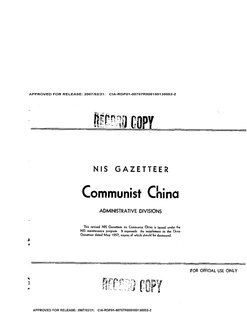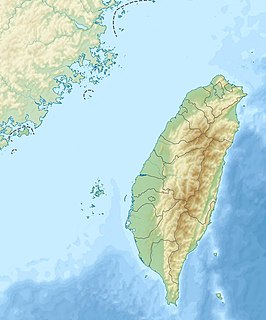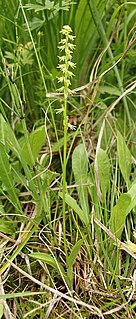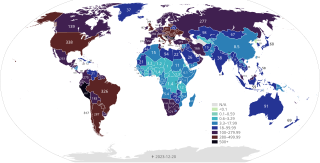
China, officially the People's Republic of China (PRC), is a country in East Asia. It is the world's most populous country, with a population of around 1.4 billion. Covering approximately 9.6 million square kilometers, it is the world's third or fourth-largest country by area. The country is officially divided into 23 provinces, five autonomous regions, four direct-controlled municipalities, and the special administrative regions of Hong Kong and Macau.

The giant panda, also known as the panda bear or simply the panda, is a bear native to South Central China. It is characterised by its bold black-and-white coat and rotound body. The name "giant panda" is sometimes used to distinguish it from the red panda, a neighboring musteloid. Though it belongs to the order Carnivora, the giant panda is a folivore, with bamboo shoots and leaves making up more than 99% of its diet. Giant pandas in the wild will occasionally eat other grasses, wild tubers, or even meat in the form of birds, rodents, or carrion. In captivity, they may receive honey, eggs, fish, yams, shrub leaves, oranges, or bananas along with specially prepared food.

Taiwan, officially the Republic of China (ROC), is a country in East Asia. Neighbouring countries include the People's Republic of China (PRC) to the northwest, Japan to the northeast, and the Philippines to the south. The main island of Taiwan has an area of 35,808 square kilometres (13,826 sq mi), with mountain ranges dominating the eastern two-thirds and plains in the western third, where its highly urbanised population is concentrated. The capital is Taipei, which, along with New Taipei and Keelung, forms the largest metropolitan area of Taiwan. Other major cities include Kaohsiung, Taichung, Tainan and Taoyuan. With 23.57 million inhabitants, Taiwan is among the most densely populated countries.

The tiger is the largest extant cat species and a member of the genus Panthera. It is most recognisable for its dark vertical stripes on orange-brown fur with a lighter underside. It is an apex predator, primarily preying on ungulates such as deer and wild boar. It is territorial and generally a solitary but social predator, requiring large contiguous areas of habitat, which support its requirements for prey and rearing of its offspring. Tiger cubs stay with their mother for about two years, before they become independent and leave their mother's home range to establish their own.

Wade–Giles is a romanization system for Mandarin Chinese. It developed from a system produced by Thomas Francis Wade, during the mid-19th century, and was given completed form with Herbert A. Giles's Chinese–English Dictionary of 1892.

Magnolia is a large genus of about 210 flowering plant species in the subfamily Magnolioideae of the family Magnoliaceae. It is named after French botanist Pierre Magnol.

The South China Sea is a marginal sea of the Western Pacific Ocean. It is bounded in the north by the shores of South China, in the west by the Indochinese Peninsula, in the east by the islands of Taiwan and northwestern Philippines, and in the south by Borneo, eastern Sumatra and the Bangka Belitung Islands, encompassing an area of around 3,500,000 km2 (1,400,000 sq mi). It communicates with the East China Sea via the Taiwan Strait, the Philippine Sea via the Luzon Strait, the Sulu Sea via the straits around Palawan, the Strait of Malacca via the Strait of Singapore, and the Java Sea via the Karimata and Bangka Strait. The Gulf of Tonkin is also part of the South China Sea, and the shallow waters south of the Riau Islands are also known as the Natuna Sea.

The Taiwan Strait, also known as the Formosa Strait, is a 180-kilometer (110 mi)-wide strait separating the island of Taiwan and continental Asia. The strait is currently part of the South China Sea and connects to the East China Sea to the north. The narrowest part is 130 km (81 mi) wide.

Forage is a plant material eaten by grazing livestock. Historically, the term forage has meant only plants eaten by the animals directly as pasture, crop residue, or immature cereal crops, but it is also used more loosely to include similar plants cut for fodder and carried to the animals, especially as hay or silage. The term forage fish refers to small schooling fish that are preyed on by larger aquatic animals.

The Chengdu J-7 is a People's Republic of China fighter aircraft. It is a license-built version of the Soviet Mikoyan-Gurevich MiG-21, and thus shares many similarities with the MiG-21. The aircraft is armed with short-range, infrared homing air-to-air missiles and mainly designed for short range air-to-air combat. The aircraft also used for close air support.

The People's Liberation Army Air Force, also known as the Chinese Air Force (中国空军) and the People's Air Force (人民空军), is an aerial service branch of the People's Liberation Army, the regular armed forces of the People's Republic of China. The PLAAF was officially established on 11 November 1949 and it is composed of 5 branches which are aviation, anti-aircraft artillery, surface-to-air missiles, radar, and Airborne Corps.

Struthio is a genus of birds in the order Struthioniformes, whose members are the ostriches. It is part of the infra-class Palaeognathae, a diverse group of flightless birds also known as ratites that includes the emus, rheas, and kiwis. There are two living species of ostrich, the common ostrich and the Somali ostrich. They are large flightless birds of Africa who lay the largest eggs of any living land animal. With the ability to run at 70 km/h (43.5 mph), they are the fastest birds on land. It is farmed worldwide, particularly for its feathers as they are used as decoration and feather dusters. Its skin is also used for leather products.

The Chengdu J-10 (simplified Chinese: 歼-10; traditional Chinese: 殲-10; also known as Vigorous Dragon, is a single-engine, lightweight multirole fighter capable of all-weather operation, configured with a delta wing and canard design, with fly-by-wire flight controls, and produced by the Chengdu Aircraft Corporation for the People's Liberation Army Air Force. The J-10 is mainly designed for air-to-air combat, but may also perform strike missions.

Herminium is a genus of plants in family Orchidaceae, widespread across much of Europe and Asia.
Leucania humidicola is a species of moth of the family Noctuidae. It is found from the Antilles to Brazil and probably the Galapagos.

The Chengdu J-20, also known as Mighty Dragon, is a single-seat, twinjet, all-weather, stealth, fifth-generation fighter aircraft developed by China's Chengdu Aerospace Corporation for the People's Liberation Army Air Force (PLAAF). The J-20 is designed as an air superiority fighter with precision strike capability; it descends from the J-XX program of the 1990s.
Bhutanthera is a genus of terrestrial orchids native to the Himalaya Mountains of Asia.
Limonia humidicola is a species of limoniid crane fly in the family Limoniidae. It can be found in Southern Canada, across the United States, and into Central America, commonly in shady, wet areas along streams.

The COVID-19 pandemic, also known as the coronavirus pandemic, is an ongoing global pandemic of coronavirus disease 2019 (COVID-19) caused by severe acute respiratory syndrome coronavirus 2 (SARS-CoV-2). It was first identified in December 2019 in Wuhan, China. In the first 50 days of the COVID-19 pandemic, despite the virus having spread to two more countries outside China, most of the global community was not particularly worried, as the perception was that only those who had come into contact with the Wuhan seafood market, where the first case was thought to have occurred, had the highest probability of being infected. The World Health Organization declared the outbreak a Public Health Emergency of International Concern on 20 January 2020, and later a pandemic on 11 March 2020. As of 22 March 2021, more than 123 million cases have been confirmed, with more than 2.71 million deaths attributed to COVID-19, making it one of the deadliest pandemics in history.

Coronavirus disease 2019 (COVID-19) is a contagious disease caused by severe acute respiratory syndrome coronavirus 2 (SARS-CoV-2). The first case was identified in Wuhan, China, in December 2019. The disease has since spread worldwide, leading to an ongoing pandemic.
















